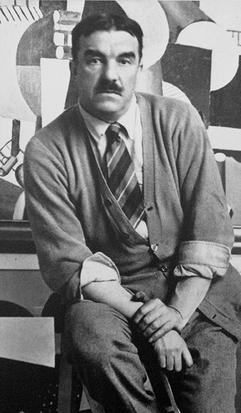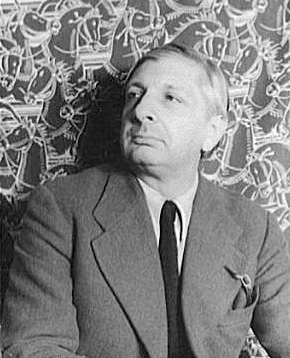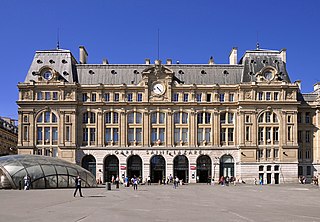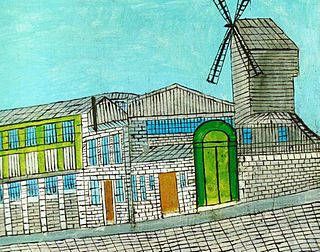
Édouard Manet was a French modernist painter. He was one of the first 19th-century artists to paint modern life, as well as a pivotal figure in the transition from Realism to Impressionism.
Montparnasse is an area in the south of Paris, France, on the left bank of the river Seine, centred at the crossroads of the Boulevard du Montparnasse and the Rue de Rennes, between the Rue de Rennes and boulevard Raspail. It is split between the 6th, 14th, and 15th arrondissements of the city. Montparnasse has been part of Paris since 1669.

Joseph Fernand Henri Léger was a French painter, sculptor, and filmmaker. In his early works he created a personal form of cubism which he gradually modified into a more figurative, populist style. His boldly simplified treatment of modern subject matter has caused him to be regarded as a forerunner of pop art.

Gare Montparnasse, officially Paris Montparnasse, is one of the seven large Paris railway termini, and is located in the 14th and 15th arrondissements.

Giuseppe Maria Alberto Giorgio de Chirico was an Italian artist and writer born in Greece. In the years before World War I, he founded the scuola metafisica art movement, which profoundly influenced the surrealists. His best-known works often feature Roman arcades, long shadows, mannequins, trains, and illogical perspective. His imagery reflects his affinity for the philosophy of Arthur Schopenhauer and of Friedrich Nietzsche, and for the mythology of his birthplace.

Gare d'Austerlitz, officially Paris Austerlitz, is one of the seven large Paris railway terminal stations. The station is located on the left bank of the Seine in the southeastern part of the city, in the 13th arrondissement. It is the start of the Paris–Bordeaux railway; the line to Toulouse is connected to this line. In 1997, the Ministry of Culture designated the Gare d'Austerlitz a historical monument; it became the fifth large railway station in Paris to receive such a label, as currently only Montparnasse has not been attributed it.

The Gare Saint-Lazare, officially Paris Saint Lazare, is one of the seven large mainline railway station terminals in Paris, France. It was the first train station built in Paris, opening in 1837. It mostly serves train services to western suburbs, as well as intercity services toward Normandy using the Paris–Le Havre railway. Saint-Lazare is the third busiest station in France, after the Gare du Nord and Gare de Lyon. It handles 290,000 passengers each day. The current station building opened in 1889 and was designed by architect Juste Lisch; the maître d'œuvre was Eugène Flachat.

The School of Paris refers to the French and émigré artists who worked in Paris in the first half of the 20th century.

The Song of Love is a 1914 painting by Italian metaphysical painter Giorgio de Chirico. It is one of the most famous works by Chirico and an early example of his pre-surrealist style, though it was painted ten years before the movement was "founded" by André Breton in 1924.
Transilien is the brand name given to the commuter rail network serving Île-de-France, the region surrounding and including the city of Paris. The network consists of nine lines: H, J, K, L, N, P, R, U, and V each operated by SNCF, the state-owned French railway company. The lines begin and end in major Parisian stations, except for lines U and V which connect major stations outside the Paris city borders. Unlike the RER network, the Transilien trains do not cross through the Paris city centre.

The Melancholy of Departure is an oil on canvas painting by the Italian metaphysical painter Giorgio de Chirico, from 1916. This painting was created after Chirico returned to Italy from Paris to join the Italian Army in World War I. It is held at the Tate Modern, in London.

The Railway, widely known as Gare Saint-Lazare, is an 1873 painting by Édouard Manet. It is the last painting by Manet of his favourite model, the fellow painter Victorine Meurent, who was also the model for his earlier works Olympia and the Luncheon on the Grass. It was exhibited at the Paris Salon in 1874, and donated to the National Gallery of Art in Washington, D.C. in 1956.
Agustín Lazo Adalid was a Mexican artist and playwright who is credited with introducing surrealism to Mexico. Although he grew up during the era of the Mexican Revolution, his time in Europe in the 1920s and early 1930s, set his aesthetics towards the avant-garde movements of that continent, rather than towards Mexican muralism, making him a part of the Los Contemporáneos or “Grupo sin grupo.” His work in art and theater influenced each other, with his art having theatrical themes and his theater having emphasis on sets and visual cues. Lazo retired from art in 1950, after the death of his long-time partner poet Xavier Villaurrutia, supposedly never painting or writing again.

Louis Vivin was a French primitivist painter.

The Soothsayer's Recompense is a 1913 painting by Italian painter Giorgio de Chirico. It is now in the Philadelphia Museum of Art as part of the permanent collection. It was accessioned in 1950 as one of the thousand items donated to the institution by Walter and Louise Arensberg. The piece was created in France, through a process of "squaring-up" in which Chirico drew a version of the piece divided into nine squares, and subsequently used this draft to quickly create the fleshed-out painting.

Arrival of the Normandy Train, Gare Saint-Lazare, also known as The Railway Station of Saint Lazare in Paris, is a c. 1877 oil-on-canvas painting by Claude Monet. It is in the permanent collection of the Art Institute of Chicago.

Gare Saint-Lazare is a series of oil paintings by the French artist Claude Monet. The paintings depict the smoky interior of this railway station in varied atmospheric conditions and from various points of view. The series contains twelve paintings, all created in 1877 in Paris. This was Monet's first series of paintings concentrating on a single theme.

The Temple is a painting made in 1949 by the Belgian artist Paul Delvaux. It depicts a classical temple building in moonlight, with the head of a statue and several modern objects in the foreground. The painting was made in Choisel outside Paris where Delvaux lived temporarily with his lover and future wife Anne-Marie "Tam" de Maertelaere. It is an oil painting with the dimensions 113.7 cm × 146 cm.

The Train in the Snow, or Le train dans la neige, is a landscape painting by the French Impressionist artist Claude Monet. The work depicts a train surrounded by snow at the Argenteuil station in France. Art historians see the work as a significant example of Monet's efforts to integrate nature and industry in his work. Many historians believe that Monet, out of all of the notable nineteenth century artists, made the most paintings of trains in his lifetime.
















